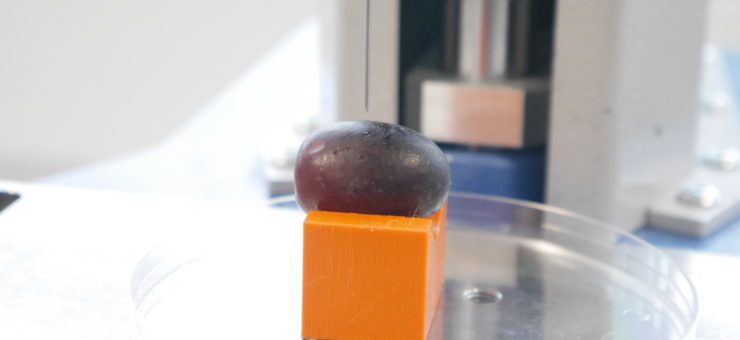How much force do you need to pierce a grape…and other questions
29 June 2022
Springboard engineers shine at the office opening party with industry-related demonstrations.
It was with great pleasure that we welcomed friends, industry partners and clients to our offices for drinks and networking last week to celebrate our new premises.
To entertain our guests while they admired the new labs and workshops, we challenged our engineers to come up with some cool and interesting games. The team did not disappoint, and our visitors had a few tricky challenges on their hands!
No compasses allowed
In one of the general-purpose labs, users were asked to draw a perfect, 5-cm-diameter circle on a sheet of paper. An imaging rig we’d built in just a few days, with some custom software, then automatically assessed how well each person did (in terms of both size and circularity), read their handwritten name, and compiled a leaderboard. Although this demonstrator was designed just to kindle our guests’ competitive instincts, it is an illustration of how quickly a computer vision setup can be made to analyse devices under test, control quality on a production line, or even monitor hand tremors in patients with Parkinson’s disease.
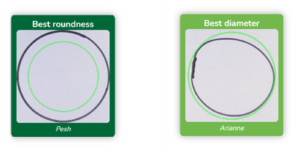
Top of the leaderboard
Seeing the invisible
Another hit was showing the power and fallibility of the infrared camera. Most people were familiar with the use of infrared imaging to measure temperatures. However, many were surprised to see that using this camera, a window acts as a mirror; and conversely silicon, which we normally consider opaque, is quite transparent. Understanding how infrared light interacts with different materials is essential to correct interpretation of its measurements, and can help inform design decisions in everything from heating systems to drug container materials.
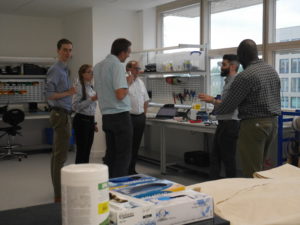
Visitors enjoying the results of the infrared camera
Imperfect pitch
How can you analyse the inner workings of a device that you can’t open? This is a common challenge for developers of devices for which the caseworks are tightly integrated into their function, like many autoinjectors. The Springboard engineers showed how audio spectrograms can provide a non-invasive check-up on the performance of a prototype syringe driver. Just for fun, we also asked our visitors to listen to a pure frequency, and challenged them to match it by adjusting the length of a cantilever plucked with a plectrum. The results highlighted how audio analysis allows a closer, more accurate inspection than our ears alone could determine, and interestingly showed that the great majority of players’ judgments were flat!
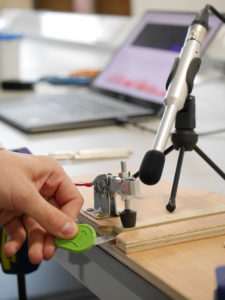
The audio spectogram in action
What’s in the box, a prosthetics brainstorm and subtle simulations
Our visitors also enjoyed:
- an interactive demonstration of root cause analysis, in which users tried to figure out the cause of a malfunction in a device in a systematic way;
- seeing the process and output of a brainstorming session on the design of a 3D printed prosthetic that would enable its wearer to use a brake on a bicycle;
- demonstrations of COMSOL multiphysics simulation software to illustrate the potential and pitfalls of finite element analysis, and how it has proved valuable in past projects
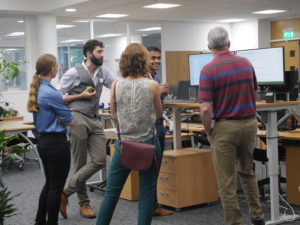
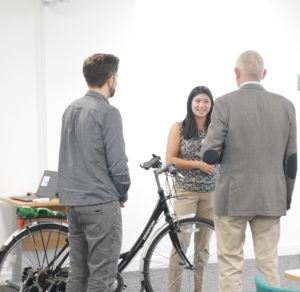
Friends, colleagues and clients joining in on the fun
Under the (grape) skin
Many of Springboard’s clients have worked with us on injection devices, from autoinjectors to infusion pumps. To exemplify some of the challenges in that area, we put one of our tensometers to the test by using it to drive a needle through the skin of a grape. The forces involved in doing so proved to be surprisingly similar to those involved in human injections (as judged from the literature, not on our visitors!). This type of testing is often useful in the design stage (for example to calculate the required strength of a driving spring in an autoinjector), or in verification (to confirm that the injection force from a device is as expected).
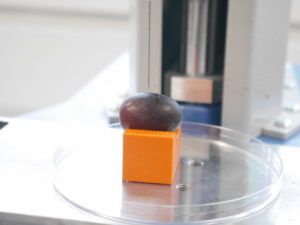
Forces involved in piercing the skin of a grape
We had a great time at the party and hope our guests did too. If you would like to take a tour next time you are in Cambridge, please let us know. We’d love to see you.


